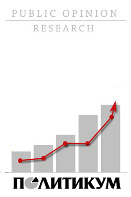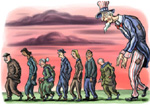| NSPM in English | |||
The Great Recession Continues |
 |
 |
 |
| петак, 22. јануар 2010. | |
|
(The Wall Steet Journal, January 21, 2010)
The unemployment rate managed to hold at 10% in December only because of an extraordinary shrinkage in the labor force: Some 661,000 gave up looking for a job. Bureau of Labor Statistics' (BLS) nonfarm payroll data indicate that December job losses totaled 85,000. But the bureau's household survey, a better and more comprehensive measure of both the unemployed and underemployed, indicated a loss of 589,000 jobs. Since the Great Recession began in 2007, some 8.6 million jobs have been lost, according to the bureau; and small businesses, the normal source for new jobs, are still shedding workers. Fewer than 10% added employees, while more than 20% cut back—and the cuts averaged nearly twice as many per firm as the hires at the expanding companies. Unemployment, in short, has graduated from being a difficulty, a worry. It is now a catastrophe, with some 15.3 million Americans out of work, according to the BLS. What about the future? The problem in the job market going forward is not so much layoffs in the private sector, which are abating, but a lack of hiring. The federal stimulus program is offset by a 2010 budget shortfall for state, city, county and school districts, which the Center on Budget and Policy Priorities recently estimated will be in the range of an astonishing $200 billion nationally. Since virtually all states and cities have to run balanced budgets, the result will be reduced services, layoffs and tax hikes. The consequence is that the U.S. economy—for decades the greatest job creation machine in the world—is taking longer and longer to replace the jobs already lost. In the 1970s and 1980s, Jane Sasseen noted in a recent report in BusinessWeek, it took as little as one year from the end of a recession to add back the lost jobs. After the eight-month downturn ending in March of 1991, for example, jobs came back in 23 months. After the downturn from the dot-com bust in 2001, it took 31 months. This time it could take as many as five years or even more to recover all of the eight-plus million jobs lost since March 2007. That's because we would have to create an additional 1.7 million jobs annually beyond those for the 1.3 million new people who enter the work force every year. Economists may see the recession as being over, but the man on the street does not. Roughly 60% of the public believes the recession still has a way to go, a NBC/Wall Street Journal poll reported last October. Even those who have not suffered know someone—a friend, a neighbor, a family member—who is being hurt. Two in three say the rally in the stock market has not changed their views. There are sound reasons for this gloom. Consumers have learned a bitter lesson. They understand that increased consumption—private and public—will have to come from income and not borrowing, and income will have to come from employment. Today, mainstream Americans are going on a financial diet amid deteriorating family finances. They know now that they cannot spend what they don't have, as the painful consequences of spending levels that were artificially pumped up by too much debt have hit home. The top 20% of the nation's households account for 40% of all spending, according to government data reported by Ylan Q. Mui in the Washington Post last September. But these households no longer trust their home equity or rising stock portfolios (up by almost $5 trillion this past year) as a basis for spending in lieu of saving. All they see ahead are taxes, taxes, taxes. So the dollars have not yet started to flow. This is the new normal. What this means is that larger-than-typical head winds face two of the three normal engines of recovery: consumption and residential investment. Rather than pumping more cash into a fragile economy to make up this difference, the government will have to focus on its next big task: drawing up credible plans for bringing bloated budget deficits under control without triggering another downturn. The prospect, therefore, is sluggish GDP growth; employment gains that are too slow to prevent further increases in the unemployment rate; and firms still very reluctant to hire vigorously. How can we accelerate a substantial recovery in job growth that will generate additional labor income? There is no snap answer. But this is no argument for inertia. We must have programs that create some degree of confidence that America can be rebuilt, and jobs can be created, especially since consumer spending will likely decline as a part of GDP for many years. The unemployed have to be supported. But it would be better if the financial support employed labor in rational, long-term, major infrastructure projects, processed by a newly created National Infrastructure Bank. These wouldn't be entitlement programs, but regeneration programs. Government spending on infrastructure projects—broadband Internet access across the nation, restoring decaying bridges and canals, building high-speed railways, modern airports, sewage plants, ports—has a high multiplier effect for adding jobs to the economy. And we will be fulfilling a desperate national need. A second avenue for increasing employment would be to enhance technology, the area of our greatest strength. We are depriving ourselves of productive talent by a fearful attitude toward immigration. We make it hard for bright people to come and we make it hard for them to stay, so once they have graduated from our universities they go home to work for our competitors. This is not the way to run a railroad. Foreign students are a significant proportion of those with graduate degrees in the hard sciences in American universities. We should restore the quotas for H-1B visas to 195,000 annually (where it was in the early 2000s) from 65,000, where it is now. This increase has been blocked by shortsighted special-interest groups that fear jobs will be taken from Americans. On the contrary. The kind of people we should be striving to keep are those whose work in technology and engineering provides more than their share of new jobs. Technology and innovation have long given us our greatest job growth. Just think: In 1800, about three-quarters of the U.S. labor force was devoted to agriculture. Today, it is less than 3%. Manufacturing employed one-third of the work force at the end of World War II. Today, it is down to about one-tenth. Americans are accustomed to economic transformation. We must follow rational economic policies in the interest of the nation and not in the interest of narrow parochial groups who lobby legislators. Otherwise, as illustrated by the sorry journey of health-care legislation, we will see more of the politics of corruption. Mr. Zuckerman is chairman and editor in chief of U.S. News & World Report |
Од истог аутора
Остали чланци у рубрици
- Playing With Fire in Ukraine
- Kosovo as a res extra commercium and the alchemy of colonization
- The Balkans XX years after NATO aggression: the case of the Republic of Srpska – past, present and future
- Из архиве - Remarks Before the Foreign Affairs Committee of the European Parliament
- Dysfunction in the Balkans - Can the Post-Yugoslav Settlement Survive?
- Serbia’s latest would-be savior is a modernizer, a strongman - or both
- Why the Ukraine Crisis Is the West’s Fault
- The Ghosts of World War I Circle over Ukraine
- Nato's action plan in Ukraine is right out of Dr Strangelove
- Why Yanukovych Said No to Europe

.jpg)








 The December jobs report has doused the hope that we were at the beginning of a sustained economic recovery.
The December jobs report has doused the hope that we were at the beginning of a sustained economic recovery.













